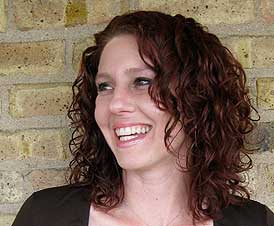you’ve crossed paths with any teenagers lately, you’ve no doubt witnessed them texting, e-mailing, and social networking—or talking on their cell phones about how they just texted, e-mailed, or visited a social networking site. Technology and modern communication devices are not just an accessory to teens today, but a part of the fabric of how they relate to one another and to the rest of the world. Think about how much has changed in less than one generation: I actually dialed a rotary phone when I wanted to spread juicy gossip in high school and had to wait three days for my film to be developed if I wanted to pass around an incriminating photograph.
When writing about contemporary teens in young adult fiction, it’s critical to represent today’s young people in believable situations. But how do you integrate technology into a storyline without making the work seem dated? Or leave technology out without appearing out of touch? And how important is it to keep current with the latest gadgets and online tools?
If you’re writing reality-based fiction for young adults—or even middle-graders—you’ll likely need to work technology into your manuscript or be able to effectively work around it. The good news is that a number of YA authors and editors are doing it well, and they’ve agreed to share their tips.
Here’s their how-to guide for incorporating modern technology into believable plots that can withstand the test of time.
Keeping it Real
To maintain credibility with the skeptical young adult audience, a book’s characters, setting, and plot have to be real to the reader. These days, that means acknowledging that most kids have cell phones, computer access, digital photo and video capabilities, and caller ID, whether your character does or not.
“You want to make the story seem realistic and set it firmly in a time period, but you don't want to distract your readers with peripheral details or worse, date your book for future generations,” says Mary Kole, an agent at Andrea Brown Literary Agency. “Especially when you're dealing with young readers, who are at the forefront of technology, you also don't want to come off as out of the loop.”
Whether it makes its way into your story or not, Esther Hershenhorn, author, writing coach, and writing teacher, recommends thinking about how your characters would use technology. “Ask yourself what is on their iPod? What do they tweet? What does an instant message from the character look like?” she advises. “Consider these questions as a way of developing your character, and then decide how much of this information to use based on what your characters would really do and how they would use the technology in the context of your story.”
Many YA authors draw from their past experiences when crafting tales about contemporary teens, making Hershenhorn’s advice even more critical. If you’re older than twenty-five, the way you got asked out on a date, spread a rumor, or made a new friend has probably changed significantly. Though young adults have shared the same roller-coaster experiences for decades, they certainly play out differently in the Internet era. Jenny Meyerhoff, author of the middle-grade novel Third Grade Baby, knows that first hand. Meyerhoff based her first young adult novel, Queen of Secrets (due out in June), in part on her experiences as a teen.
“Though young adults have shared the same roller-coaster experiences for decades, they certainly play out differently in the Internet era.”
“In the first draft, I relied heavily on my own memories; but during the revision process, I realized that some details needed to be updated,” Meyerhoff explains. “For example, a teenager today would never have a message waiting for them at home. They would have been called on their cell phone.”
In Laura Ruby’s YA books, technology plays a starring role. Her 2008 novel, Good Girls, explores how a single photograph distributed electronically changes the main character’s life. Her interest in how technology affects the lives of teens was inspired by observing her stepchildren during those critical years. “I was fascinated by the way it changed their interaction with their peers and also with their parents—making it more frequent, but sometimes less meaningful,” Ruby explains. “Also, it was hard to ignore the fact that technology made bullying a lot easier. People who would never dream of roughing up another kid in the cafeteria didn't think twice about pressing ‘send’ and passing along malicious gossip or a salacious photo.”
Technology can also be used to tell an old story in a new way. In Ruby’s recently released Bad Apple, a girl is accused of having an affair with her art teacher. “I wasn't as concerned with telling the story of a student-teacher affair—there are other novels that do this—as I was with telling the story of a girl who doesn't have control of her own narrative,” Ruby says. “Because of the rumor mill—which includes blogs, social networking sites, and cell phones—other people have the opportunity to imagine what the main character did or didn't do, without any input from her.”

“It was hard to ignore the fact that technology made bullying a lot easier.”
(Photo: Laura Ruby)
Don’t Sound Lame
If technology plays a central or supporting role in your YA manuscript, you’ll want to be certain to keep it fresh. A reference to MySpace, for example, is probably going to make your work sound dated before it even crosses the editor’s desk. Considering how long it takes a typical YA novel to go from first draft to publication, being general is the best way to keep contemporary YA, well, contemporary by the time it hits the shelves.
Meyerhoff says she leaned toward being less specific because of the tone and type of book she was writing. “I shied away from using the names of specific songs or singers,” she says. “But I felt certain that cell phones and iPods would be around for a while.”
Stacy Cantor, editor at Walker Books for Young Readers, also encourages more generic references. “Sure, your character could be texting,” she says. “But texting on the iPhone 3GS or the BlackBerry Pearl will probably become outdated before the book even publishes.”
If you find that some of your references are too specific or on their way out already, going from specific to generic can be a simple fix. “Sometimes it really is a matter of just doing ‘search and replace’,” adds Kole.
To avoid the issue altogether, some writers use parody to incorporate technology without the risk of having a specific tool or site fall out of favor before the ink is dry. Kole provides this example: I typed a message into my BrainBerry and gave Lexie a wink on her FacePlace page. “Though it is a little cheesy for my taste, tons of writers have made it work,” she admits.

“That scene in romantic comedy films where someone makes the mad dash to the airport to explain their feelings is completely out of date now.”
(Photo: Jenny Meyerhoff)
Plots That Rock
The fact that certain devices even exist has forever altered some classic scenes from books and films. Getting lost in the woods isn’t quite so frightening when you can GPS your way home. Uncovering the clues to solve a mystery or discover the identity of a suspect simply isn’t as engaging in the age of Google. That horrifying phone call from the terror-inducing stalker loses its edge when your caller ID identifies him before you even pick up the phone.
“Getting lost in the woods isn’t quite so frightening when you can GPS your way home.”
“That scene in romantic comedy films where someone makes the mad dash to the airport to explain their feelings is completely out of date now,” Meyerhoff muses. “They could just call the person on their cell phone!”
If a situation for your characters could be easily fixed with a common bit of technology, you may need to take a second look. “If you’re writing a scene where your character is trying to solve a problem, and you find yourself thinking: Gee, this would be so much easier for these characters if they could just call each other on their cell phones, you probably need to find another way to put your characters in the difficult situation,” Cantor recommends.
An honest critique group can help you look for scenarios like these and provide feedback on whether a part of your story rings true without the use of technology.
“If you’re choosing not to include common aspects of technology, be sure you have a good reason that is clear to the reader.”
When Out is In
Despite its central role in the lives of most teens, modern devices don’t have to factor into every YA novel. If technology is simply not a part of the story you want to tell, it can be left out of your tale as long as it makes sense for the characters. “Even though technology is ever-present in our lives, it doesn't have to be ever-present in our stories,” says Kole. “There are plenty of novels that deal in contemporary realities without mentioning technology.”
If you’re choosing not to include common aspects of technology, be sure you have a good reason that is clear to the reader.
For example, technology is sometimes missing from YA because it would affect the pace and overall feel of a story in a detrimental way. Cantor cites the example of her work with author Danette Haworth on the middle-grade novel Violet Raines Almost Got Struck by Lightning. “The overall feel we were going for was a sense of simplicity,” Cantor explains. “The author set the story in the past—somewhere around the 1970s—and this had the easy effect of taking away any concerns over technology encroaching on the story being told.”
However, she cautions authors against using the past as a quick fix to the technology dilemma. “It worked in this instance because it melded with the story the author was already trying to tell,” she explains.
When Cantor worked with author Jessica Warman on Breathless, she says that the inclusion of cell phones would have caused issues with the plot, in which the main character receives anonymous phone calls. “Since the story took place at prep school, the author simply stated at the very beginning that cell phones weren’t allowed on campus and that each dorm room had a land line for incoming calls,” Cantor explains. “It felt, to me at least, very seamless.”
In addition to setting your story in the past or in a situation where devices exist but are not allowed, other techniques that can effectively lead to a minimal use of technology include:
- Remote settings where there’s no electricity or cell phone reception
- Fantasy or magical realism, in which you make the rules
- Historical fiction
- Quirky characters or families who don’t embrace modern life
- Poverty or financial struggles that lead to a character’s inability to follow the crowd
“I don’t recommend going out of your way to make a manuscript current,” Meyerhoff advises. “Telling a good story trumps everything.”
UR Story = 4Ever
Though choices about the use of technology in contemporary YA can present a challenge, it’s important to focus on your end goal and listen to your instincts.
“I don’t recommend going out of your way to make a manuscript current,” Meyerhoff advises. “Telling a good story trumps everything.”
Cantor agrees. “In my favorite, contemporary YA, the stories feel like they transcend time and place; and if they do incorporate technology, it feels like an accessory, not a crutch.”
Ruby encourages writers to focus on the experiences and emotions of teens, regardless of how technology evolves. “Though technology has changed the speed and style of communication, teenagers are still teenagers,” she noted. “They're still struggling to find themselves, still trying to connect with one another, still trying to find their place in the world. I don't think any new phone or computer will ever change that.”
***

BJ Marshall has been a freelance writer since she was a teen writing for her hometown newspaper on a typewriter. Though she conducted interviews on a rotary phone in the early years, she did not actually use it to spread gossip. She lives in suburban Chicago with her husband and three children, who could e-mail and text before they could walk. Read more about her at www.bjmarshall.net.